Understanding eLearning Statistics in 2026: Key Data & Emerging Trends

The eLearning industry has experienced rapid adoption in recent years, revolutionizing the way people access education and training. The shift from traditional classrooms to online learning has enabled greater flexibility, accessibility, and personalization for learners worldwide.
And while the eLearning market started its significant expansion in the early 2000s, we are still at the beginning of its transformative impact. There is much more potential yet to be realized. According to recent market projections, the online learning industry is expected to continue expanding at a strong Compound Annual Growth Rate (CAGR), reflecting the increasing demand for digital education solutions.
What is eLearning and Why is it Growing
eLearning is defined as the use of technology to facilitate learning, encompassing everything from online courses and virtual classrooms to digital textbooks and interactive modules.
Unlike traditional methods, which often require learners to be present at a specific time and place, eLearning offers the flexibility to study at one’s own pace and on their own schedule. This flexibility is a main factor behind the rise in eLearning adoption.
According to a recent survey, 63% of students prefer online learning because it allows them to tailor their studies to fit their lives. Conversely, traditional learning methods can be restrictive, limiting access for those with busy schedules or geographic constraints.
eLearning opens up new learning opportunities for a wider audience, making education more inclusive and adaptable to individual needs.
Global eLearning Market Overview
Since 2000, the eLearning industry has expanded by over 900%, driven by the increasing number of online learners and platforms worldwide. This makes it one of the fastest‑growing sectors in education.
For instance, the global online learning market is projected to reach almost $400 billion by 2026 while maintaining a CAGR of 9.1%.
The rate of eLearning market expansion accelerated significantly during the covid-19 pandemic, which acted as a catalyst for the surge in eLearning adoption. However, in the post-pandemic world, these trends continue as online education remains a preferred choice for many.
In 2025, the U.S. online education market is estimated at $87.5–99.8 billion, representing nearly 50% of global revenue. The numbers behind this growth include millions of new user sign-ups, rising revenue figures, and increasing engagement rates across major platforms.
Regional eLearning Market Overview
eLearning adoption and revenue vary significantly across regions. Most industries across these regions are adopting eLearning to keep up with rapid technological and market changes. Below is a snapshot of market share, user bases, and key growth drivers per region based on recent analytics.
In the Asia-Pacific region, the eLearning industry is experiencing rapid growth, with India emerging as a major market due to its large user base and strong revenue projections.
Overall, different regions are working to adapt to new digital learning environments, ensuring that educational institutions, organizations, and learners remain competitive and resilient.
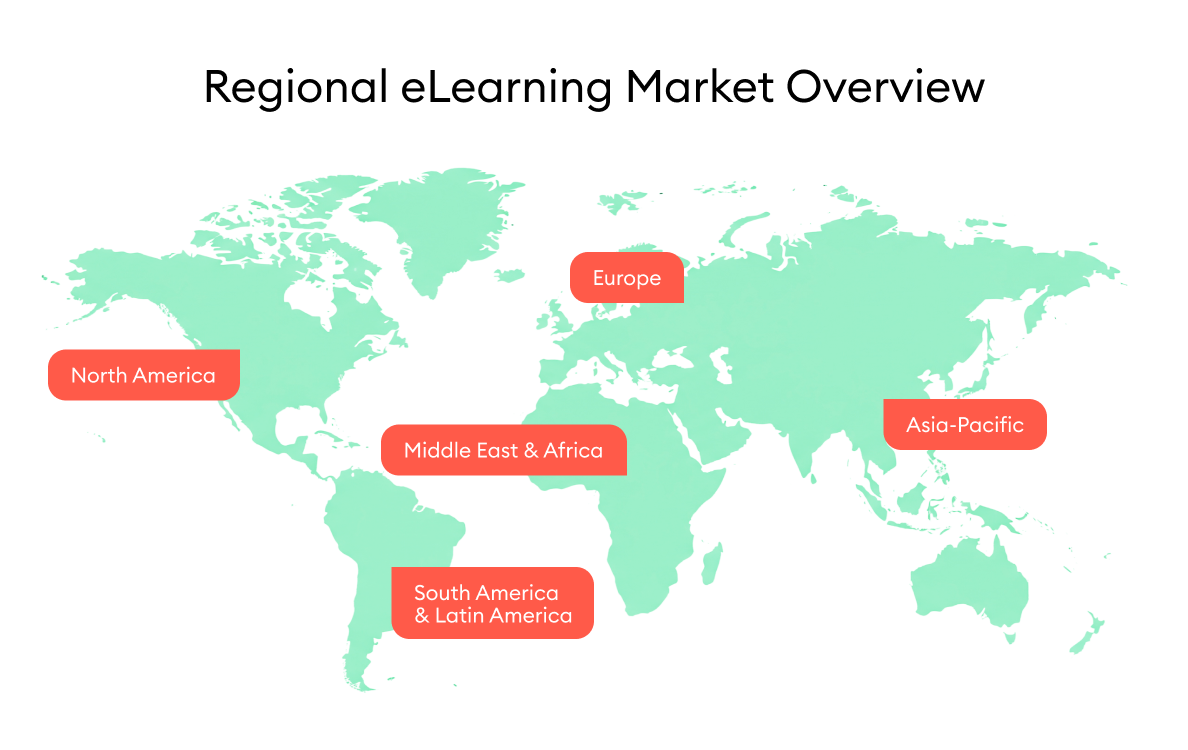
North America (≈ 35% of global eLearning usage in 2024)
- User base: ~525 million learners.
- Corporate vs Academic split: ~58% corporate, ~42% academic.
- Strengths:
– High mobile adoption ~54% of users
– Cloud platforms power ~75% of LMS deployments
– AI integrated into ~43% of systems - Drivers:
– Enterprise training infrastructure, strong LMS adoption in higher ed and corporate sectors.
Europe (≈ 25% of global usage in 2024)
- User base: ~375 million learners.
- Corporate vs Academic split: ~55% corporate, ~45% academic
- Features:
– Mobile learning usage around 51%
– Cloud LMS adoption at ~70%
– AI presence in approximately 39% of platforms
– Localization and regulatory compliance is increasingly common (e.g. GDPR, accessibility).
Asia‑Pacific (≈ 28% of global usage in 2024)
- User base: ~420 million learners
- Corporate vs Academic split: ~50% corporate, ~50% academic.
- Mobile-first region: ~60% of online education delivered via smartphone devices, with ~85% penetration
- Cloud-based adoption: ~65%, AI-enabled systems ~35%
- Growth:
– Asia Pacific led global eLearning service revenue in 2024 (~29% share), at $86.8 billion
– India is a key driver of this growth, with one of the largest eLearning user populations and rapidly increasing revenue projections, positioning it among the top global markets.
– Fastest CAGR projected (~21–24%) between 2025 and 2030.
Middle East & Africa (≈ 12% of global usage in 2024)
- User base: ~180 million learners.
- Corporate vs Academic split: ~45% corporate, ~55% academic
- Adoption rates:
– K–12 ~48%, higher ed ~78%
– Mobile learning ~52%, cloud ~58% adoption, AI integrated into ~22% of LMS platforms - Pending potential: Government digital education frameworks are expanding; approximately 75 million learners reached via national initiatives
South America & Latin America
This region covers ~8–9% of global online education, with both corporate and academic growth steady in emerging economies.
Mobile penetration is increasing rapidly; regulatory support and infrastructure investments are driving region-specific initiatives.
Source: https://www.marketgrowthreports.com/market-reports/elearning-market-115091
Regional eLearning statistics Summary
| Region | Share of Global eLearning | Key Characteristics | Growth Outlook |
|---|---|---|---|
| North America | ~35% | Mature corporate + academic infrastructure, high AI/cloud adoption | Stable growth, leading revenue |
| Europe | ~25% | Strong compliance standards, blended learning & mobile steady | Moderate growth, regulatory-driven |
| Asia‑Pacific | ~28% | Mobile-first, high government investment in digital learning | Fastest CAGR (~21–24%) |
| Middle East & Africa | ~12% | Emerging infrastructure, government-led digital education campaigns | High potential, growing rapidly |
| Latin America | ~8–9% | Infrastructure development, mobile uptake | Developing market with growth room |
Top Contributing Sectors to the eLearning Market in 2025
According to recent segmentation data, Corporate Learning represents ~58% of total global eLearning usage. This makes it the single largest sector by revenue and scale, driven by enterprise training budgets, compliance initiatives, onboarding, and continuous skill development. The eLearning sector is a major part of the broader learning industry, which is experiencing rapid growth and significant market expansion worldwide.
Most industries are now leveraging eLearning for workforce development and compliance, reflecting the widespread adoption of digital training solutions across various sectors.
In 2024, corporate training alone generated about USD 245.5 billion and is expected to grow at ~13% CAGR through 2027.
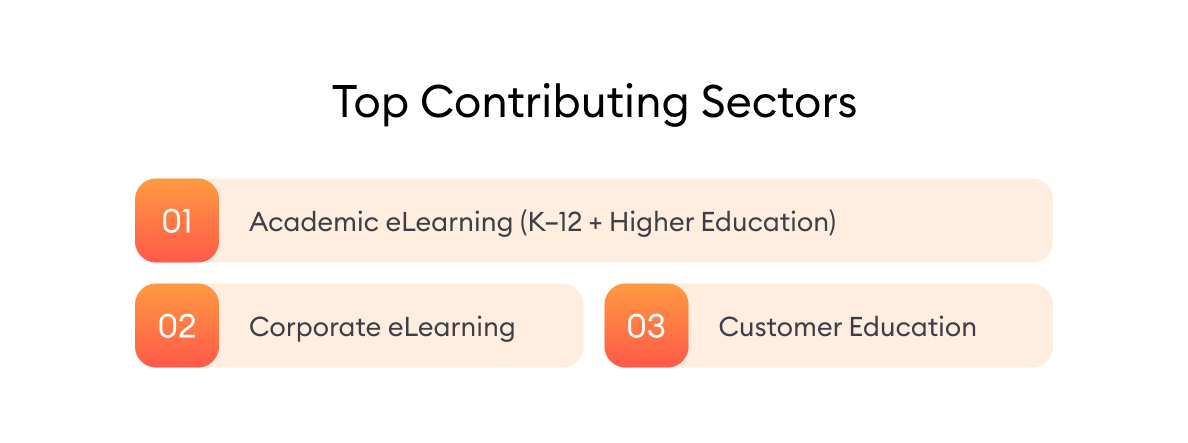
Academic eLearning Statistics (K‑12 + Higher Education)
A significant proportion of undergraduates are now enrolling in online or hybrid courses, reflecting a shift in educational preferences. The number of students studying online continues to grow rapidly, with many reporting positive impacts on their learning experiences.
Most students now prefer or benefit from online learning, as shown by recent data highlighting widespread adoption across educational levels. Additionally, a large portion of students have participated in both online and on-campus courses, demonstrating engagement with multiple learning formats.
This segment makes up approximately 42% of the global eLearning, and is further divided as follows:
Higher Education (~53% of academic segment)
- Accounts for the majority of academic eLearning – roughly 22–23% of the total global market.
- Nearly 94% of universities offer blended or fully online programs and 91% use an LMS.
- A significant percentage of undergraduates now participate in online education, with enrollment rates particularly high in certain fields of study.
- The proportion of male students in online higher education remains lower than that of female students, reflecting a gender gap in enrollment.
- Focused on continued education, professional certifications, and hybrid learning delivery.
K‑12 (~47% of academic segment)
- Represents about 19–20% of the global market.
- Many schools now operate via hybrid or digital models, with 67% of K‑12 institutions offering some form of online education.
Corporate eLearning Statistics
- Approximately 98% of corporations plan to use or have adopted online learning. Many organizations are switching from traditional in-person training to online solutions, which can significantly reduce costs and streamline employee development processes.
- The corporate eLearning market reached $141 billion in 2022, projected to grow at ~15.5% CAGR until 2032. Despite the perception that online education and training can be expensive—especially when compared to traditional four-year degrees or private non-profit online colleges—switching to eLearning often results in substantial cost savings for companies.
- Implementation of eLearning has reportedly increased revenue for ~42% of companies, due to higher productivity and efficiency. Online learning programs can also increase employee engagement by up to 18% when implemented effectively, while providing valuable development opportunities that help retain talent and address skills gaps.
- According to IBM experience, every $1 invested in online learning returns about $30 in productivity gains. Executives and managers are key participants in eLearning initiatives, driving organizational learning and ensuring alignment with business goals.
Corporate Trends & ROI
- 40–60% less time is required for online training compared to traditional methods, and switching to online training can significantly reduce costs and streamline employee development processes.
- 61% of L&D professionals cite skill‑gap closure as the primary goal of eLearning programs, emphasizing the importance of offering development opportunities to retain employees and address skills gaps.
- Online learning programs can increase employee engagement by up to 18% when implemented effectively in a corporate setting.
- Use of AI in corporate learning: 30% of L&D teams use AI‑powered tools; 91% plan to increase usage, and AI personalization can boost learning efficiency by ~57% .
Customer Education Statistics
Customer education has emerged as a vital trend within the eLearning landscape, enabling organizations to deliver training and support directly to their customers. Through online tutorials, webinars, and digital resources, companies can empower users to get the most out of their products and services. This approach not only enhances the customer experience but also plays a strategic role in building loyalty and reducing support costs.
Understanding the impact and evolving trends in customer education is essential for organizations aiming to maximize the effectiveness of their eLearning initiatives.
Customer Training Trends & Impact
Recent research highlights the powerful impact of customer training on business outcomes. For instance, studies have found that well-designed customer training programs can boost customer retention rates by up to 25%.
By equipping customers with the knowledge and skills to use products or services effectively, organizations can minimize common issues and increase overall satisfaction. For example, a software company that offers comprehensive online training modules enables its users to become proficient more quickly, reducing the need for ongoing technical support. These solutions not only streamline the onboarding process but also foster long-term customer relationships.
As eLearning continues to evolve, customer training remains a key strategy for organizations seeking to deliver value and differentiate themselves in competitive markets.
eLearning Statistics for Corporate eLearning Tools & Platforms
Learning Management Systems (LMS)
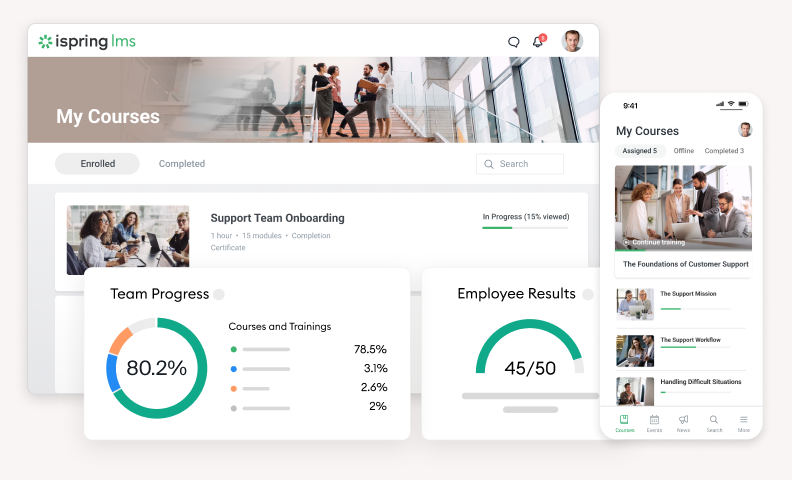
These platforms lead enterprise adoption due to strong features, scalability, and ROI:
iSpring LMS
Serves as a unified corporate LMS and authoring platform. It supports rapid course creation, extensive analytics, and mobile/offline learning. Known for its ease of use among non-technical creators and strong performance in multi-tenant corporate environments, iSpring LMS offers scalable licensing, enterprise-grade security, and around‑the‑clock support.
Continu
Rated one of the top enterprise LMS for 2025, scoring high on enterprise readiness, AI integration, compliance, analytics, and mobile support.
Docebo
Recognized for its AI-powered personalization, automation, collaboration tools, and deep enterprise integrations—commonly adopted by midsize to large companies.
360Learning
Popular for social learning, peer-based onboarding, collaborative content creation, and intuitive course design. Ideal for internal training and employee engagement.
TalentLMS
A streamlined platform favored by SMEs for fast setup, ease-of-use, and built-in authoring tools – especially in remote or hybrid environments.
Absorb LMS & LearnUpon
Enterprise-grade platforms known for compliance support, advanced reporting capabilities, multiple learning portals, and strong L&D workflows.
SAP Litmos
Cloud-based LMS is often preferred by mid-to-large organizations for scalability, off-the-shelf course libraries, and SAP integration.
Cornerstone OnDemand
A leader in talent and compliance training with an estimated 12% share of corporate LMS revenue — valued for its enterprise governance, skill management, and performance tools.
Moodle Workplace & Moodle (Enterprise variants)
Open-source platforms widely used in corporate settings for maximum customization and multilingual support. Moodle holds ~10%–30% share in academic and corporate markets, depending on region.
Mobile Learning & eLearning Apps Statistics
While LMS platforms often include mobile support, several other tools enhance mobile-first and microlearning delivery in various ways, such as through dedicated apps, microlearning content, and interactive modules:
- Many major LMS providers – including iSpring, Docebo, TalentLMS, Absorb, and Continu – offer native mobile apps optimized for offline access, interactive modules, and SCORM/xAPI tracking. These platforms support different methods of student engagement, making education more accessible.
- Specialized microlearning and mobile-first platforms mentioned by industry professionals include LearnWorlds, Learnie, Paradiso LMS, and KnowVela, which are frequently recommended in real-world use cases focused on smartphone-based learning delivery.
- iSpring Suite merits attention as an authoring tool with mobile-ready publishing. It includes iSpring mobile player apps for iOS and Android that support offline course consumption and LMS sync on reconnection.

Virtual learning through these mobile platforms offers flexibility and convenience, allowing learners to balance their education with personal and professional responsibilities.
eLearning Tools and Platforms Summary
| Platform / Tool | Typical User Base | Distinctive Features |
|---|---|---|
| Continu | Large enterprises | Top-rated LMS, AI, mobile, analytics |
| Docebo | Mid-large enterprises | Personalization, automation, social learning |
| 360Learning | Mid-enterprises | Collaborative, peer teaching, quick content creation |
| TalentLMS | SMEs | Ease-of-use, fast deployment, cost-effective |
| Absorb LMS / LearnUpon | Mid-market | Compliance tools, multi-portal, robust reporting |
| SAP Litmos | Large enterprises | Scalable content, strong integrations |
| Cornerstone OnDemand | Global enterprises | Talent management, performance-focused LMS |
| Moodle Workplace / Enterprise variants | Academic & corporate | Customizable, open-source, wide regional usage |
| LearnWorlds, Paradiso LMS, etc. | Mobile-first environments | App-centric design for microlearning |
| iSpring Suite + Mobile Player | Content authors/training | PowerPoint conversion, offline access, mobile sync |
Why These Platforms Lead in Corporate eLearning
- AI-enhanced personalization: Tools like Docebo and Continu use machine learning to tailor learning paths and boost engagement.
- Mobile-first design: Platforms support on‑the‑go access via native apps, offline viewing, and microlearning formats.
- Gamified activities: Leading platforms incorporate various gamified activities and challenges to enhance learner engagement and motivation.
- Enterprise integrations: Seamless connections with HRIS, CRM, calendars, and compliance systems (e.g. Docebo, Cornerstone, SAP Litmos).
- Rapid course creation workflows: Platforms like 360Learning and TalentLMS enable swift internal content generation.
- Scalability: Tools vary from lightweight SME tools (TalentLMS) to full-featured enterprise systems (Cornerstone, Continu).
Most Common Skills Taught in Corporate eLearning
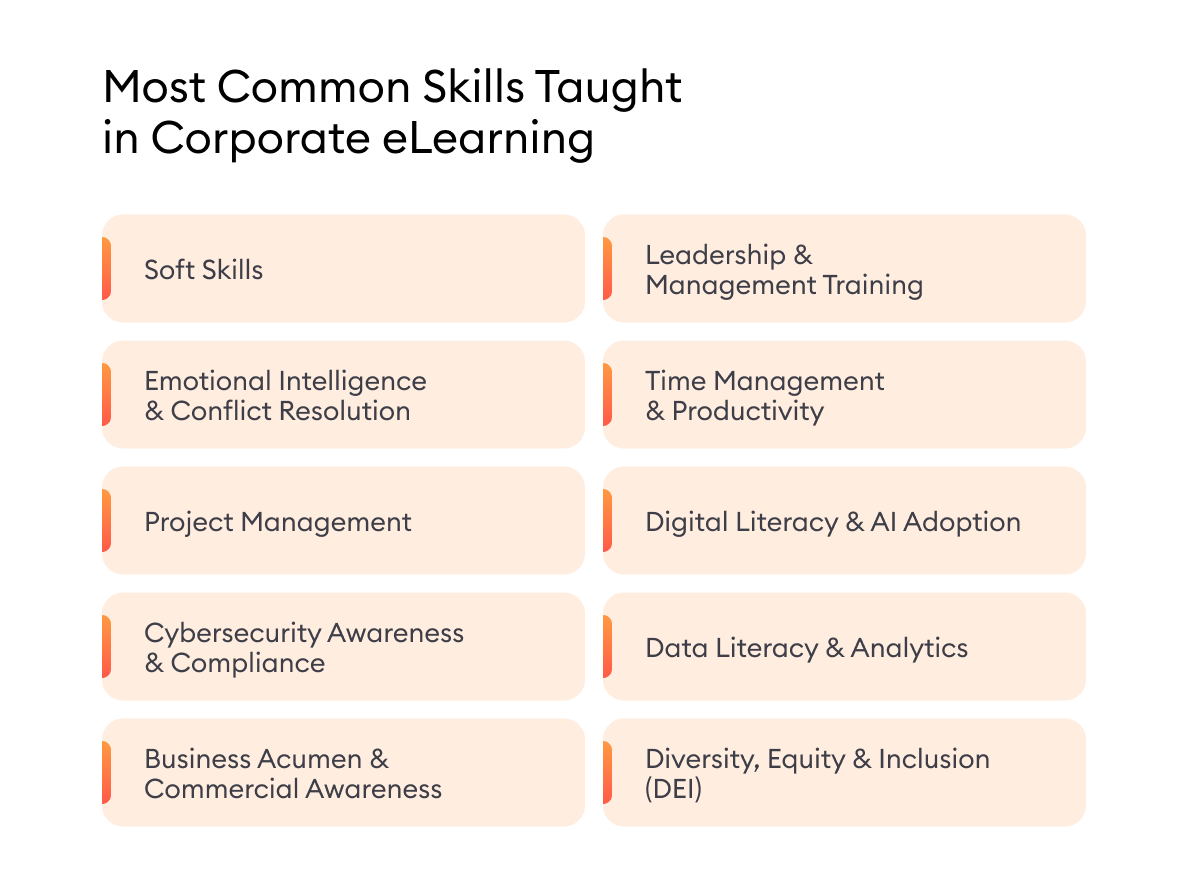
Soft Skills
Soft skills remain foundational across all corporate training portfolios – especially as remote and hybrid work becomes normal. These include:
- Communication skills (verbal, written, active listening)
- Emotional intelligence (EQ), empathy, conflict resolution, teamwork
- Leadership and management development
- Adaptability, resilience, creativity, critical thinking
These are consistently ranked as top training themes in modern L&D programs.
Leadership & Management Training
Training for both current and aspiring managers focuses on:
- Team leadership and high-performance team dynamics
- Coaching, mentoring, decision‑making, and strategic thinking
- Conflict resolution and EQ-driven leadership styles
This is commonly listed among the highest priority corporate training topics worldwide.
Emotional Intelligence & Conflict Resolution
Courses in EQ and conflict management are taught to:
- Develop self-awareness, empathy, emotional regulation
- Enhance communication and collaboration in teams
- Support remote/hybrid workplace dynamics
These frequently feature in contemporary L&D agendas.
Time Management & Productivity
With intensifying workloads and hybrid setups, training emphasizes:
- Prioritization techniques, overcoming procrastination
- Tool-based productivity tactics (e.g. time-blocking)
- Enhancing work–life balance and efficiency
These skills are among the most requested year after year.
Project Management
Essential for roles with planning and coordination responsibilities, courses cover:
- Agile methodologies, Scrum, PMP frameworks
- Risk mitigation, cross-functional execution, stakeholder communication
Training in this area is integral to successful strategic execution.
Digital Literacy & AI Adoption
These areas address the increasing need for tech-savvy employees:
- Fluency with cloud tools, spreadsheets, collaboration platforms
- Awareness and responsible use of AI in daily workflows
- Ethical implications of automation and bias mitigation
It is essential for students and employees to become familiar with new digital tools and AI technologies to participate effectively in eLearning and modern workplaces.
With digital transformation accelerating, these are in high demand across all roles.
Cybersecurity Awareness & Compliance
Typical coverage includes:
- Phishing prevention, secure browsing, password hygiene
- Understanding data protection regulations (e.g. GDPR, HIPAA)
- Reporting protocols and corporate security culture
These skills are mandated for all employees as cyber threats grow.
Data Literacy & Analytics
Courses centered on building analytical capacity:
- Excel, Power BI, Tableau for dashboards and decision-making
- Interpreting KPIs, identifying trends, data-informed strategy
Essential for roles in business analysis, product teams, and managers.
Business Acumen & Commercial Awareness
Programs designed to:
- Illuminate organizational operations and financial metrics
- Enhance strategic thinking and value-based decision-making
- Align learning outcomes with business objectives
These skills help employees “think like the business,” supporting growth and leadership readiness
Accessibility and Inclusion
Accessibility and Inclusion training includes modules on:
- Unconscious bias, cultural competence, and inclusive leadership
- Accessibility awareness and equity in team dynamics
- Creating psychologically safe environments and respectful workplaces
Accessibility and Inclusion is now considered a core corporate responsibility and learning theme.
Most Common Corporate Skills eLearning Statistics
| Skill Category | Typical Focus Areas |
|---|---|
| Soft Skills / EQ | Communication, leadership, teamwork, resilience, creativity |
| Leadership & Management | Coaching, decision-making, conflict resolution, strategic thinking |
| Emotional Intelligence & Conflict | Empathy, self-awareness, negotiation, hybrid collaboration |
| Time Management & Productivity | Task prioritization, workflow optimization, balance |
| Project Management | Agile/Scrum, planning, execution, stakeholder communication |
| Digital Literacy & AI | Cloud tools, AI fundamentals, digital adaptation |
| Cybersecurity Awareness & Compliance | Phishing, access control, regulation awareness |
| Data Literacy & Analytics | Excel, data tools, dashboard creation, data-informed decision-making |
| Business Acumen | Strategic thinking, financial literacy, business alignment |
| Accessibility and Inclusion | Bias reduction, inclusive leadership, cultural awareness |
Higher Education & Academic eLearning Statistics
- Online learning retains 25–60% more knowledge than in-person education, while requiring 40–60% less study time, without sacrificing effectiveness.
- 81% of students report improved academic performance using digital learning tools.
- Worldwide, ~49% of learners have completed some form of online learning, and 70% consider it more effective. About half of all learners have now participated in online courses, a significant increase compared to prior years before the widespread adoption of eLearning.
- However, low income students often face challenges in accessing online learning due to limited technology and internet connectivity, highlighting a persistent digital divide.
Global Learner Satisfaction with eLearning in 2025
Global Satisfaction Rates
A meta-analysis of 52 studies across 26 countries, involving ~93,700 participants, found that student satisfaction with online education averaged 59.5%, compared to 75.3% of faculty and 70.7% of parents
Perception & Experience
A survey of over 27,000 UK university students reported that 80% rated their online learning quality as above average, with 71% confirming it helped them progress. However, only 49% found online learning engaging and motivating.
Many organizations and students find that while online learning offers flexibility and accessibility, it can be challenging to maintain engagement and motivation throughout the course.
Learner Preferences & Engagement Drivers
Approximately 90% of learners cite convenience and flexibility as reasons they prefer online learning. When choosing online education, many learners also consider factors such as career advancement opportunities and the ability to align studies with personal interests.
78% prefer self-paced learning, and 58% favor learning at their own pace.
85% report better comprehension and retention when using interactive or multimedia content.
Features linked to satisfaction include mobile-friendly interfaces (65%), video content usage (above 70–92%), and gamification elements (up to 60% boost in engagement).
Customer Experience Factors
According to a 2025 report, 56% of learners say instructor responsiveness affects their satisfaction. 55% cite navigation difficulties as a barrier. 65% cite mobile-friendly design as important. Learners are 73% likely to recommend platforms with strong support.
Regional & Environmental Variations
Learners from developing countries or those under emergency transition conditions (e.g. pandemic-era online classes) showed notably lower satisfaction, in part due to poor connectivity, technical issues, and limited interactivity.
For international students in China, average satisfaction score was around 2.90/5, with many expressing dissatisfaction with interaction levels and course design; over 32% would not recommend online courses.
eLearning Statistics for Global Learner Satisfaction
| Metric | Value / Insight |
|---|---|
| Student Satisfaction Average | ~59.5% globally |
| Faculty Satisfaction | ~75% |
| Parental (K–12) Satisfaction | ~71% |
| Learners Survey Rating (UK HE) | ~80% rated quality above average |
| Engagement & Motivation (UK) | ~49% found online learning engaging |
| Self-Paced Preference | ~58–78% |
| Improved Retention via Interactive Content | ~85% |
| Course Recommendation (CX Report) | ~73% likely to refer platform |
| Instructor Responsiveness Impact | ~56% learners say it affects satisfaction |
eLearning Benefits and Challenges
eLearning brings a host of benefits to both learners and organizations, including greater flexibility, cost savings, and improved accessibility. Learners can access content anytime and anywhere, making education more inclusive for those with varying needs or limited mobility. However, the shift to digital learning also presents challenges.
Significant investment in technology and infrastructure is often required to ensure seamless delivery and accessibility for all users. Organizations must balance the promise of online learning with the need to provide reliable platforms, robust support, and ongoing updates to keep pace with technological advancements.
Key Benefits of eLearning in 2025
One of the standout advantages of eLearning in 2025 is its effectiveness in addressing the skills gap across industries. According to a recent survey, 93% of businesses recognize eLearning as essential for upskilling their workforce. By allowing employees to learn at their own pace, organizations can reduce reliance on traditional classroom training and minimize disruptions to daily operations.
For example, in the accounting sector, eLearning enables professionals to stay updated with the latest regulations, tools, and technologies—ensuring compliance and maintaining a competitive edge. This approach not only helps bridge the gap between current and required skills but also supports continuous professional development. As technology and industry trends evolve, eLearning remains a critical solution for organizations aiming to keep their employees informed, agile, and ready to meet new challenges.
Emerging Trends in Digital Learning
- Microlearning (bite‑sized modules) is now mainstream in corporate L&D, supporting short attention spans and just‑in‑time training. This trend started to gain momentum in recent years as organizations recognized the need for flexible, accessible learning options.
- Mobile learning is growing at ~27% annually, with enterprises designing mobile‑first content and micro‑modules. To start implementing new eLearning trends like mobile learning, organizations should assess their current infrastructure and provide training for both learners and instructors.
- AI‑driven personalization is reshaping training: 57% efficiency gains, cost‑savings of 20–30%, and scalable tailored experiences.
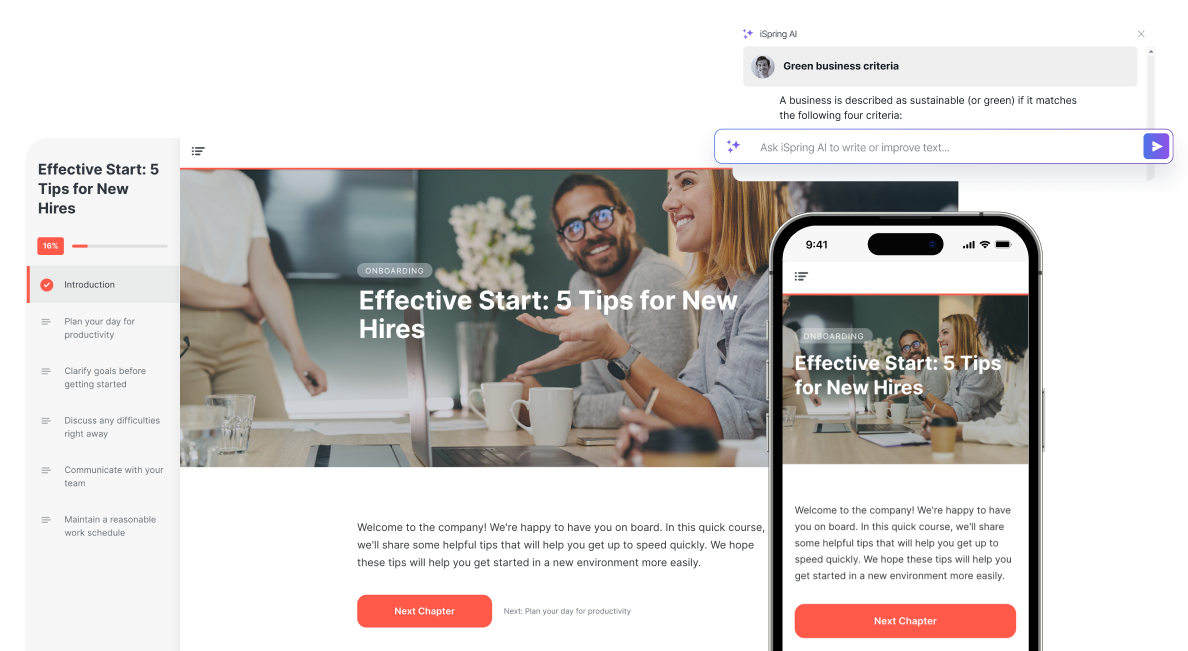
Mobile Learning & Accessibility
- The mobile learning market is expected to reach $77.4 billion by 2025, reflecting the shift toward smartphone-based training.
- Learner preference trends indicate that 58–68% of employees favor learning at their workplace or at their own pace.
LMS Usage Trends
- Around 89–93% of companies worldwide use a Learning Management System (LMS) for online learning. Of those platforms, approximately 55% are cloud-based, while the remainder remains on-premise.
- 83% of organizations manage LMS internally, with 23% outsourcing operations.
Learning Outcomes & ROI
- eLearning improves retention (25–60%), speeds up training (by 40–60%), and boosts employee performance by 15–25%.
- Online course completion incentives can lift rates from 35% to 85%. Employees at companies offering eLearning are up to 36% more likely to stay long-term.
Future Outlook: What’s Next in eLearning?
- The global eLearning market is expected to reach $1 trillion by 2030–2032, driven by AI, AR/VR, MOOCs, and adaptive learning systems.
- The ongoing adoption and innovation in online education continue to shape the future of eLearning, with institutions and students increasingly embracing digital learning modalities.
- Growth in AI‑in‑education market is forecasted at 37% CAGR through 2032, and AI-driven eLearning boosts engagement by ~80%.
Frequently Asked Questions
How much time does online training save compared to traditional methods?
Online training typically requires 40–60% less time than traditional learning.
Do learners retain more via eLearning?
Yes, retention rates rise from 8–10% in traditional classes to 25–60% online, depending on method and content.
What is the size of the global eLearning market in 2025?
The market is estimated between $325 billion and $400 billion, with forecasts pointing above $1 trillion by early 2030s.
Are corporations widely adopting eLearning?
Yes, by 2023, around 98% of organizations had adopted or planned adoption of online learning. Corporations use eLearning not only for compliance training but also to close skill gaps.
How is AI transforming corporate learning?
AI tools provide personalized course paths, chatbots, and predictive analytics. Nearly 30% of L&D teams already use AI, with improvements in learning efficiency of ~57% and cost savings of 20–30% .
What role does mobile learning play in eLearning?
Mobile learning is surging – growing at ~27% annually. It is vital for field employees and supports microlearning content.






